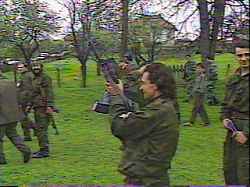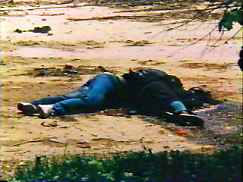
From Romeo and Juliet in Sarajevo.
| The Journal for MultiMediaHistory Volume 1 Number 1 ~ Fall 1998 |
Romeo and Juliet in Sarajevo. National Film Board of Canada, 1994. 82-minute VHS video. Produced by David Fanning, Dennis Murphy, Virginia Storring, Michael Sullivan and Mark Starowicz;
Co-produced by K.A. Productions; Director, John Zaritsky; Author, John Zaritsky.
From Romeo and Juliet in Sarajevo. |
Romeo and Juliet in Sarajevo traces the lives of this young couple from their high school graduation in 1986, the year Sarajevo hosted the Winter Olympics, through Bosko�s fateful decision to stay in the city of his birth when so many of his fellow Serbs left for safety, or to take part in the siege. Although the filmmakers build the documentary around the poignancy of the love story, the strength of the piece lies in the interviews and images that give a context to multiethnic disintegration and a city under attack.
 |
From Romeo and Juliet in Sarajevo. |
The images are equally striking. Colorful family snapshots of the prewar couple at the beach soon segue into grainy video footage of mortar massacres and children dashing across streets to foil snipers who get paid 500 DM for each dead Sarajevan.
 |
From Romeo and Juliet in Sarajevo. |
It is unclear from this documentary how
much Admira and Bosko knew of the rape campaign, the concentration camps,
and the divisions within the international community regarding what to
do about the chaos in the former Yugoslavia. Nevertheless, by personalizing
the conflict, the filmmakers have made clear the universal experiences
of some of its victims, making its horror more comprehensible and the need
for an understanding of the Balkans in the 1990s more urgent.
Linda Kelly Alkana
California State University, Long Beach
![]() Comments
to: [email protected]
Comments
to: [email protected]
Contents: JMMH, Volume 1 Number 1 ~ Fall 1998